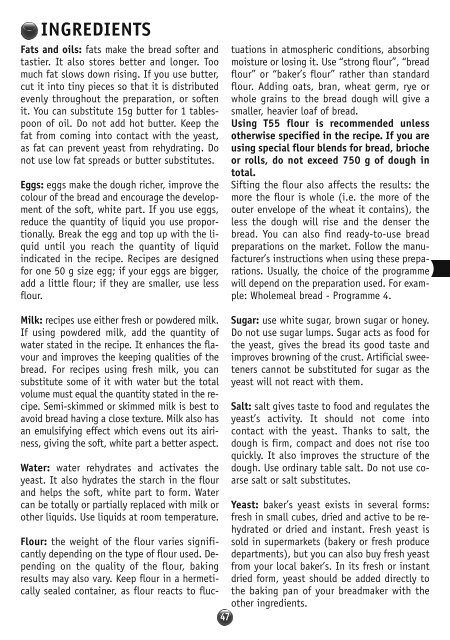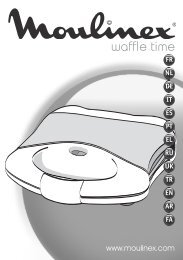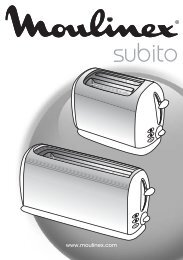home bread - bineo
home bread - bineo
home bread - bineo
Create successful ePaper yourself
Turn your PDF publications into a flip-book with our unique Google optimized e-Paper software.
INGREDIENTS<br />
Fats and oils: fats make the <strong>bread</strong> softer and<br />
tastier. It also stores better and longer. Too<br />
much fat slows down rising. If you use butter,<br />
cut it into tiny pieces so that it is distributed<br />
evenly throughout the preparation, or soften<br />
it. You can substitute 15g butter for 1 tablespoon<br />
of oil. Do not add hot butter. Keep the<br />
fat from coming into contact with the yeast,<br />
as fat can prevent yeast from rehydrating. Do<br />
not use low fat spreads or butter substitutes.<br />
Eggs: eggs make the dough richer, improve the<br />
colour of the <strong>bread</strong> and encourage the development<br />
of the soft, white part. If you use eggs,<br />
reduce the quantity of liquid you use proportionally.<br />
Break the egg and top up with the liquid<br />
until you reach the quantity of liquid<br />
indicated in the recipe. Recipes are designed<br />
for one 50 g size egg; if your eggs are bigger,<br />
add a little flour; if they are smaller, use less<br />
flour.<br />
Milk: recipes use either fresh or powdered milk.<br />
If using powdered milk, add the quantity of<br />
water stated in the recipe. It enhances the flavour<br />
and improves the keeping qualities of the<br />
<strong>bread</strong>. For recipes using fresh milk, you can<br />
substitute some of it with water but the total<br />
volume must equal the quantity stated in the recipe.<br />
Semi-skimmed or skimmed milk is best to<br />
avoid <strong>bread</strong> having a close texture. Milk also has<br />
an emulsifying effect which evens out its airiness,<br />
giving the soft, white part a better aspect.<br />
Water: water rehydrates and activates the<br />
yeast. It also hydrates the starch in the flour<br />
and helps the soft, white part to form. Water<br />
can be totally or partially replaced with milk or<br />
other liquids. Use liquids at room temperature.<br />
tuations in atmospheric conditions, absorbing<br />
moisture or losing it. Use “strong flour”, “<strong>bread</strong><br />
flour” or “baker’s flour” rather than standard<br />
flour. Adding oats, bran, wheat germ, rye or<br />
whole grains to the <strong>bread</strong> dough will give a<br />
smaller, heavier loaf of <strong>bread</strong>.<br />
Using T55 flour is recommended unless<br />
otherwise specified in the recipe. If you are<br />
using special flour blends for <strong>bread</strong>, brioche<br />
or rolls, do not exceed 750 g of dough in<br />
total.<br />
Sifting the flour also affects the results: the<br />
more the flour is whole (i.e. the more of the<br />
outer envelope of the wheat it contains), the<br />
less the dough will rise and the denser the<br />
<strong>bread</strong>. You can also find ready-to-use <strong>bread</strong><br />
preparations on the market. Follow the manufacturer’s<br />
instructions when using these preparations.<br />
Usually, the choice of the programme<br />
will depend on the preparation used. For example:<br />
Wholemeal <strong>bread</strong> - Programme 4.<br />
Sugar: use white sugar, brown sugar or honey.<br />
Do not use sugar lumps. Sugar acts as food for<br />
the yeast, gives the <strong>bread</strong> its good taste and<br />
improves browning of the crust. Artificial sweeteners<br />
cannot be substituted for sugar as the<br />
yeast will not react with them.<br />
Salt: salt gives taste to food and regulates the<br />
yeast’s activity. It should not come into<br />
contact with the yeast. Thanks to salt, the<br />
dough is firm, compact and does not rise too<br />
quickly. It also improves the structure of the<br />
dough. Use ordinary table salt. Do not use coarse<br />
salt or salt substitutes.<br />
Yeast: baker’s yeast exists in several forms:<br />
fresh in small cubes, dried and active to be rehydrated<br />
or dried and instant. Fresh yeast is<br />
Flour: the weight of the flour varies signifi- sold in supermarkets (bakery or fresh produce<br />
cantly depending on the type of flour used. De- departments), but you can also buy fresh yeast<br />
pending on the quality of the flour, baking from your local baker’s. In its fresh or instant<br />
results may also vary. Keep flour in a hermeti- dried form, yeast should be added directly to<br />
cally sealed container, as flour reacts to fluc- the baking pan of your <strong>bread</strong>maker with the<br />
other ingredients.<br />
47





